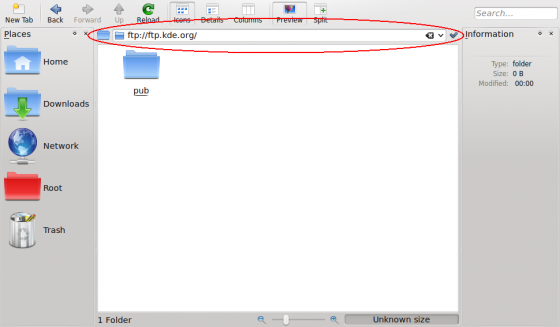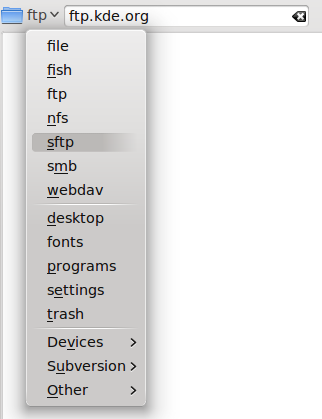File transfers: Difference between revisions
m (Typo) |
m (Minor corrections) |
||
| Line 1: | Line 1: | ||
==Introduction== | ==Introduction== | ||
This tutorial describes how to transfer files to and from a remote server using the KDE | This tutorial describes how to transfer files to and from a remote server using the KDE Software Collection, for example downloading a file from a FTP server. | ||
The KDE | The KDE SC does not include a standard FTP client as you may know it from other platforms. There are some third party applications like [http://kasablanca.berlios.de Kasablanca] or [http://userbase.kde.org/KFTPgrabber KFTPgrabber] but they are not yet fully ported to the KDE SC 4. The good news however is, you don't need such an application to manage your remote servers. The KDE SC features a way more powerfull technique for dealing with such situations. | ||
==Basic file transfers== | ==Basic file transfers== | ||
| Line 12: | Line 12: | ||
[[File:tutorials_ftp1.png|560px]] | [[File:tutorials_ftp1.png|560px]] | ||
If your server requires authentication you will be prompted for your credentials in a popup dialog. Insert username and password. If you wish to save them, check the checkbox. Dolphin will store your passwords securely in your KDE Wallet. For faster access you can insert username and | If your server requires authentication you will be prompted for your credentials in a popup dialog. Insert username and password. If you wish to save them, check the checkbox. Dolphin will store your passwords securely in your KDE Wallet. For faster access you can insert username and password directly in the address bar using this format: ftp://username:[email protected] - however we do not recommend this, as it is a security risk. Not only is it visible in your location bar, but it is stored in plain text - easy for anyone to read. Storing the password in KWallet is a much safer procedure. | ||
==Other protocols== | ==Other protocols== | ||
Revision as of 12:38, 12 April 2010
Introduction
This tutorial describes how to transfer files to and from a remote server using the KDE Software Collection, for example downloading a file from a FTP server.
The KDE SC does not include a standard FTP client as you may know it from other platforms. There are some third party applications like Kasablanca or KFTPgrabber but they are not yet fully ported to the KDE SC 4. The good news however is, you don't need such an application to manage your remote servers. The KDE SC features a way more powerfull technique for dealing with such situations.
Basic file transfers
To connect to a remote server you can use nearly all KDE applications. You may choose the appropriate application depending on the task you want to do. For example to browse a remote server the best choice would be Dolphin or Konqueror. To edit a webpage you may directly use Quanta without the need of a separate FTP application. In this example we will use Dolphin and transfer files using FTP.
Connect to a FTP server
To connect to a FTP server just open Dolphin and click on an empty place in the address bar. Type the address of your server into the address bar. Don't forget the ftp:// at the beginning:
If your server requires authentication you will be prompted for your credentials in a popup dialog. Insert username and password. If you wish to save them, check the checkbox. Dolphin will store your passwords securely in your KDE Wallet. For faster access you can insert username and password directly in the address bar using this format: ftp://username:[email protected] - however we do not recommend this, as it is a security risk. Not only is it visible in your location bar, but it is stored in plain text - easy for anyone to read. Storing the password in KWallet is a much safer procedure.
Other protocols
Now, FTP is just an example of many different protocols KDE SC supports. There is a whole lot more to explore. To see a list of all supported protocols click on the tick next to the address bar to switch to browse mode and then on the ftp button at the beginning.
Imitate a standalone FTP client using Dolphin
If you want a more standalone-ftp-client like experience you can use dolphins split view: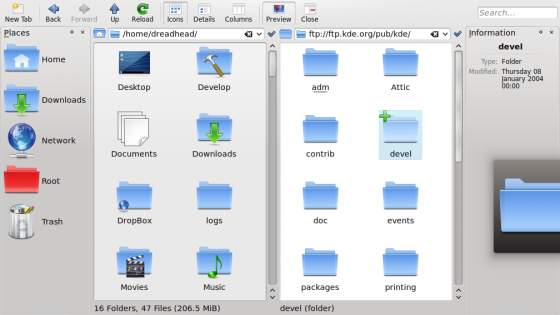
Add a remote folder to your places bar
You can drag and drop a remote folder directly to your places and bookmark it:
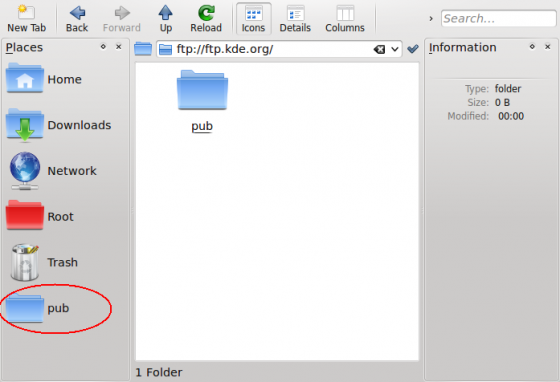
Directly access remote files in other KDE applications
As already said previously, nearly every KDE application is capable of accessing remote files and folders. For example, you can open a remote website directly in Kate by inserting the address in the file open dialog:
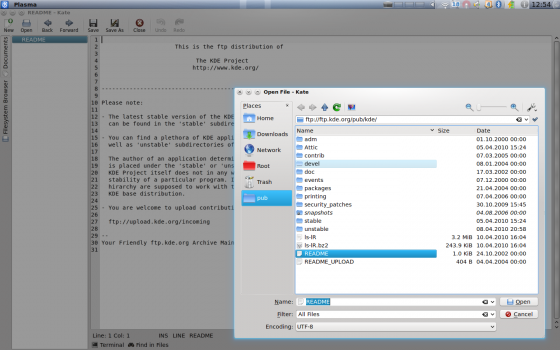 You can now edit the file in Kate. When you click "save" the file will be directly uploaded to the server. That way, you don't need to download files before editing and upload them again after editing.
You can now edit the file in Kate. When you click "save" the file will be directly uploaded to the server. That way, you don't need to download files before editing and upload them again after editing.

